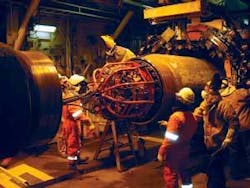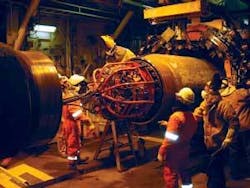OFFSHORE EUROPE
Jeremy Beckman • London
Langeled makes UK connection
Langeled, the new world’s longest subsea pipeline, began shipping first supplies of Norwegian gas to the UK mainland last month. The southern section of the 1,166-km line connects the system’s intersection point - Statoil’s Sleipner complex in the Norwegian North Sea - with the Easington reception terminal on England’s east coast.
When the northern spur section starts operating next year, gas will feed through from the Ormen Lange field in the Norwegian Sea, which eventually is projected to provide one-fifth of the UK’s requirements.
Acergy completed its portion of the installation work earlier this fall; this season, the upgradedAcergy Piper laid 354 km of 42-in. pipe between the Norwegian landfall of Nyhamna and Sleipner, the route traversing the treacherous Norwegian Trench in water depths of up to 385 m.
The contractor then installed a further 158-km, 42-in. section for Statoil. Acergy also recently completed tie-ins for the four-slot ‘K’ subsea template, the latest phase of Statoil’s Norne satellites project in the Norwegian Sea. The first well came onstream recently - the scheme should send a further 10 MMbbl through to theNorne FPSO.
Basalt well stops short
Statoil has called a halt to its latest exploration effort offshore the Faroe Islands. Well 6104/21-1 was plugged and abandoned 200 m short of the targeted subsurface depth of 4,400 m, due to technical difficulties. The well, drilled by the semisubStena Don, achieved better rates of penetration than expected through the basalt layers, but the result was only traces of gas.
Faroese oil and gas administration Jardfeingi claimed a few positives, pointing out that the exercise had provided useful data on the thickness of the basalt layer within the East Faroe High region. Over the next few months, samples and logs from the well will undergo further analysis, ahead of the planned third Faroese Licensing Round in fall 2007.
NW Hutton on the way out
BP aims to start dismantling its redundant North West Hutton platform some time in 2008. Heerema was appointed main contractor for removal of the 20,000-ton topside and 17,500-ton jacket, together constituting one of the most complex decommissioning jobs to date. According to London-based analysts Britboss, BP’s proposed method for the topsides, which originally were installed in 22 major lifts, involves reverse installation.
The platform, fixed in 144 m of water at a location 130 km northwest of the Shetlands, was in service for nearly 30 years before production had to be prematurely shut down in 2002 due to repeated disruptions. BP submitted the third and final draft of its decommissioning plan in spring 2005. It was approved a year later by the UK Department of Trade and Industry. During installation, the jacket was damaged, forcing BP to apply extra amounts of grout to the piles. The DTI therefore accepted BP’s plan to leave the jacket footings in place, this decision later being ratified by international decommissioning watchdog, Ospar.
BP has completed the well abandonment and topsides clean-up phases. A heavy-lift vessel will take the topsides and jacket to Able’s specialist decommissioning yard in Hartlepool, northeast England; the target is to recycle 97% of the removed materials. BP expects this and subsequent pipeline decommissioning/site inspection work to be concluded by end-2009.
Record response to Norway round
Norway’s latest Awards in Predefined Areas licensing round drew applications from 43 oil companies, almost 50% up on last year’s tally. When nominations closed at the end of September, the total solicited acreage was 61,452 sq km, making this the country’s third-largest licensing exercise to date. Of the 200 blocks requested, 121 were in the North Sea, 55 in the Norwegian Sea, and 24 in the Barents Sea.
The idea behind the Predefined Areas (APA) system is to speed up exploration in mature quadrants; production licenses for APA 2006 should be issued in December. However, the government also is looking to open northerly waters previously off-limits, following persistent industry lobbying.
During October, it increased the Norwegian Petroleum Directorate’s budget by NOK 70 million to finance new studies of the potential of these underexplored regions. Much of it is directed at geological mapping of the Nordland VII and Troms II areas: NPD contracted Norwegian company EMGS to conduct electromagnetic surveys over Troms II in the fish-rich Lofoten region, and that work should be completed by the end of this year.
Galley diverted to Tartan
Talisman Energy has confirmed it will redevelop Galley in UK block 15/23a, switching its production to the nearby Tartan platform via newly installed subsea facilities. Both fields were originally developed by Texaco, in Galley’s case using the semisubmersibleNorthern Producer.
The switch should extend Galley’s life, cut operating costs, and allow an extra 7MMbbl of oil to be extracted that would otherwise remain in the ground. Simultaneously, Talisman should develop the Duart accumulation 5 mi distant from Tartan (subject to government approval), via a single subsea well. At peak, both fields should boost throughput at the platform by 8,500 b/d.
Approval pending again, Talisman shortly will add to its inventory of mature North Sea strongholds. It recently signed a sale and purchase agreement to take Shell and ExxonMobil’s interests in the Auk and Fulmar fields, and associated infrastructure. Negotiations had been ongoing since April 2005.
Also in the UK central sector, Eni is looking to sell its 75% interest in block 21/28a to Canada’s Antrim Energy. The acreage includes the undeveloped Dandy and Fyne oil fields, which Eni inherited when it acquired Monument Oil and Gas. Eni recently commissioned new studies in a vain attempt to develop these stranded fields via an FPSO. Both were delineated by a total of eight wells drilled during 1971-98. Antrim describes them as combination structural-stratigraphic traps comprising Mid-Eocene, Tay Formation sandstones, with secondary potential in the underlying Jurassic.

